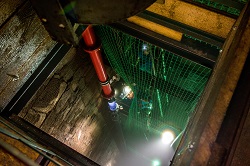Sustainable extraction of raw materials from oceanic depths
Deep-sea mineral deposits comprise an alternative source of raw materials for Europe’s renewable energy sector. Increasing commodity prices mean that the idea of sourcing metals from the ocean floor is now becoming more attractive to investors. However, the extreme conditions found in the ocean depths pose major technical and environmental challenges that are entirely different to land-based mining. The EU-funded BLUE MINING project addressed challenges associated with the extraction of deep sea minerals, ranging from their discovery and assessment, to exploitation technologies and the necessary legal and regulatory framework. “The consortium provided breakthrough solutions for a sustainable deep-sea mining value chain by developing the technical capabilities to adequately and cost-effectively discover, assess and extract deep sea mineral deposits at depths of up to 6 000m,” says project coordinator Dr Jort van Wijk. Researchers aimed to conduct more reliable and accurate exploration surveys for seafloor massive sulphides (SMS), extinct SMS deposits (eSMS) and sea floor manganese nodules (SMnN). New sensor technologies were then developed to rapidly find deep sea deposits and more accurately assess their dimensions. New tools and sensors New geophysical tools, improved predictive mapping techniques and sampling enabled fast and reliable mapping and modelling of potential resources. The team has developed approaches on how to measure sustainable mining operations by indicators and how to foster positive responsible behaviour of entrepreneurs by incentives. Further developed tools allow for spatial management and control of seafloor areas and the sustainable use of their resources. These tools can be used as a blueprint for mining feasibility studies of deep sea minerals. During research voyages, scientists tested a new combined self-potential/magnetic sensor mounted on a deep-towed system, using the results to create the largest autonomous underwater vehicle-based map of the ocean floor. “Our new model indicates that many of the smaller deposits are likely to be more economically viable than estimates based on the volume of the mound alone would suggest,” claims the project’s principal investigator Dr Bramley Murton. BLUE MINING developed and validated computer codes through laboratory experiments and conducted detailed simulations of riser dynamics and slurry transport processes. According to van Wijk, “These tests are necessary for validating decision support tools and to provide an impression of the problems expected when transferring large amounts of slurry at sea.” Minerals transported from the ocean floor Researchers devised a configuration of riser pipes and underwater pumping technology to move mineral resources from the seafloor to the surface over a distance up to 6 000m. “Vertical hydraulic transport was tested and monitored on a purpose-built rig having a riser of 125m in length, making it the largest vertical transport test rig in Europe for deep-sea mining,” claims van Wijk. “Ship-to-ship transfer technology was also developed for transferring the mined material from the mining vessel to the carrier-vessel.” The design of the vertical transport system paid special attention to the booster stations, resulting in the development and testing of a special deep-sea motor prototype. “The motor is filled and cooled with water due to its open structure, therefore it does not require any lubricants, minimizing the environmental impact of the motor,” van Wijk points out. BLUE MINING will ensure access to raw materials, thereby decreasing EU dependency on resource imports and strengthening Europe’s mining sector and their technology providers. It will also enable the EU to become a global leader in technology associated with the exploration and sustainable extraction of deep-sea minerals.
Keywords
BLUE MINING, riser, seafloor massive sulphides (SMS), deep-sea mining, slurry, extinct SMS deposits (eSMS), sea floor manganese nodules (SMnN), booster station







